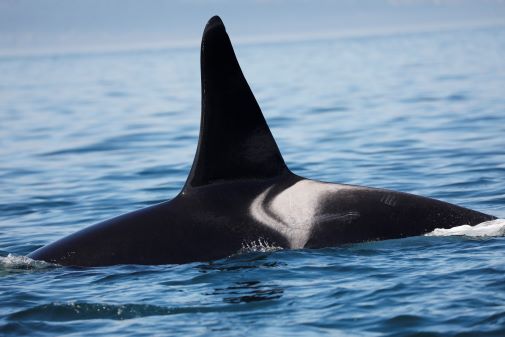Male killer whales protected by post-menopause mums
Posted on 20 July 2023
 Adult male killer whale with tooth rake marks
Adult male killer whale with tooth rake marks
Researchers from the Universities of York and Exeter collaborated with the Center for Whale Research (CWR) on the study, which found that there is growing evidence that post-menopause females boost the life chances of their offspring, especially males.
The team studied the ‘tooth rake marks’ on whales’ skin and found males had fewer marks if their mother was present and had stopped breeding.
Breeding
It is suggested that when female killer whales are reproductive, they are expending a lot of energy, but once they stop breeding, it frees up time and energy for the mothers to protect their sons.
Tooth rake marks are indicators of physical social interactions in killer whales and are typically obtained through fighting or rough play.
Researchers found that males who had mothers who were no longer breeding had 35% fewer tooth marks than other males. For males whose mother was still breeding, they found no evidence that her presence reduced tooth rake injuries.
Protective behaviour
Professor Dan Franks, from the Department of Biology, said: "Our findings offer captivating insights into the role of post-menopausal killer whale mothers. They perform protective behaviour, reducing the incidence of socially-inflicted injuries on their sons.
“It's fascinating to see this post-menopause mother-son relationship deepening our understanding of both the intricate social structures in killer whale societies and the evolution of menopause in species beyond humans."
Only six species – humans and five species of toothed whales – are known to experience menopause, and scientists have long been puzzled about why this occurs.
Post-reproductive
Charli Grimes, from the Centre for Research in Animal Behaviour at the University of Exeter, said: “We were fascinated to find this specific benefit for males with their post-reproductive mother. We can’t say for sure why this changes after menopause, but one possibility is that ceasing breeding frees up time and energy for mothers to protect their sons.”
It is thought that mothers are more likely to protect their sons over their daughters because although both males and females continue to reside with their mothers throughout her lifespan, males can breed with multiple females, so they have more potential to pass on their mother’s genes. The males also breed with females outside their social group – so the burden of raising the calf falls on another pod.
The research shows that, just as in humans, it seems that older female whales play a vital role in their societies – using their knowledge and experience to provide benefits including finding food and resolving conflict.
Research
Southern resident killer whales feed on salmon and have no natural predators apart from humans, so tooth marks on their skin can only be inflicted by other killer whales. This may happen within social groups, or when two pods meet.
The study, funded by the Natural Environment Research Council (UK) is part of long-term research on “southern resident” killer whales, which live off the Pacific coast of North America.
The published paper is available in Cell Press
Explore more news

Sodium channels in breast cancer cells a promising target for future treatments, study reveals
Thursday 25 July 2024

Cooling the classroom: University of York researchers to investigate UK schools’ responses to hot weather
Wednesday 24 July 2024

Hunter-gatherers kept an 'orderly home' in the earliest known British dwelling, study shows
Tuesday 23 July 2024

Study uses Game of Thrones to advance understanding of face blindness
Tuesday 23 July 2024

York academic contributes to new report on men’s health which reveals disparities between most and least deprived areas in the UK
Wednesday 17 July 2024
Media enquiries
About this research
Researchers collaborated with the Center for Whale Research (CWR) on a study funded by the Natural Environment Research Council (UK), which is part of long-term research on “southern resident” killer whales. This study focused on ‘tooth rake marks’ on whales’ skin.
The published paper is available in Cell Press
